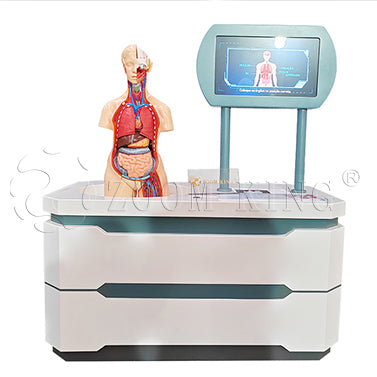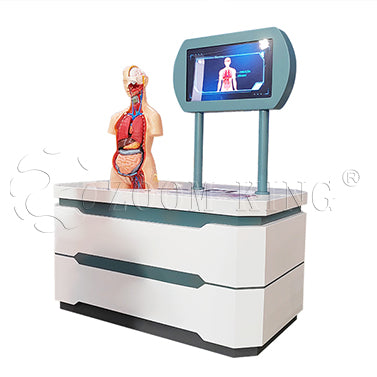Life and Health:Man puzzle


Design of the exhibit: The exhibit consists of two
elements. The first is a table holding a human mannequin with models of the major organs: lungs,
heart, liver, pancreas, stomach, intestines, kidneys,
bladder, brain, eye, etc. The organ models can be
removed to then be placed back in their proper
place inside the mannequin. The second element of
the exhibit is a touchscreen table with diagrams of
the human internal systems with descriptions of the
functions of each organ.

Activity at the exhibit: The user’s task is to place the
organ models inside the mannequin in such a way
that they all fit. This gives the opportunity to look at
them closely, see how they are positioned in relation to one another and compare their size. As the
organs are closely packed, there is only one correct
way to arrange them.
The exhibit allows several people to experiment at
the same time.

Topics: The internal organs are of a specific size
and have a specific place intended just for them,
and they are also tightly packed. This is why we feel
every change in this orderly system. The organs
function in systems whose action – coordinated by
the nervous system – is what makes us alive. The
lungs allow gas exchange and the liver, among other things, is responsible for digesting fats and proteins, regulating glucose levels and many other vital
substances in the blood, storing vitamins and minerals, cleansing the blood of harmful substances,
neutralising toxins, supporting the immune system
and blood clotting. The pancreas produces digestive
enzymes and hormones. The stomach and small
intestine are responsible for digestion of food and
absorption of nutrients. The large intestine is responsible for the absorption of water and vitamins.
The organs of the urinary system – the kidneys and
bladder – enable the removal of unnecessary and
harmful substances from the body. And, finally, the
heart – it sets the blood in motion so that it reaches
every corner of our body, supplying it with the necessary and removing unnecessary substances from
cells, organs and tissues.
Keywords: human, model, internal organs, digestive system, respiratory system, genitourinary system,
cardiovascular system, nervous system, brain
